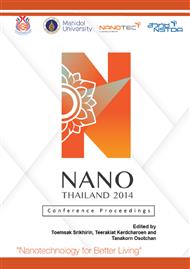p.175
p.182
p.186
p.193
p.198
p.203
p.210
p.215
p.223
Amine-Functionalized Silica Monolith as a Copper Ion Adsorbent
Abstract:
Amine-functionalized silica monoliths were prepared by co-condensation between tetraethyl orthosilicate and N-[3-(trimethoxysilyl) propyl] ethylenediamine.The mixture between ethanol, H2O, tetraethyl orthosilicate, N-[3-(trimethoxysilyl) propyl] ethylenediamine and 1M HCl was stirred for 1 hour at room temperature to obtain a clear silica sol. 1.2 g of the sol was poured into plastic vial with the paraffin cover and left for 2 days for the polymerization process to obtain the gel. The disc-shape gel was dried in the oven at 50 °C for 10 hours. The silica monolith obtained was weighed and analyzed by IR spectroscopy and BET method. The disc-shape silica monoliths were further used for copper ion adsorption studies. The factors affecting the copper ion adsorption like pH, copper ion concentration and metal ion interference were studied. The pHs of CuCl2 aqueous solutions were varied from pH 2 to pH 6. While the Cu2+ concentrations under this study were 10-1, 10-2, 10-3, 10-4, 10-5 and 10-6 M. The cationic interferences used were Cd2+ and Ni2+. For the copper ion concentration, the higher the concentration results in the higher adsorption capacity. At the lower concentrations like 10-4, 10-5 and 10-6 M, a complete adsorption was obtained. The color of the Cu2+ - loaded monolith was changed to blue due to the complex between amino groups on the silica and the Cu2+ as evidenced by IR analysis. The monolith after adsorption was also analyzed by SEM/EDS. The inferences like Cd2+ and Ni2+ affect the Cu2+ adsorption at different degree. The desorption could be successfully performed by using 0.1 M HCl solution.
Info:
Periodical:
Pages:
198-202
Citation:
Online since:
December 2015
Authors:
Price:
Сopyright:
© 2016 Trans Tech Publications Ltd. All Rights Reserved
Share:
Citation:


